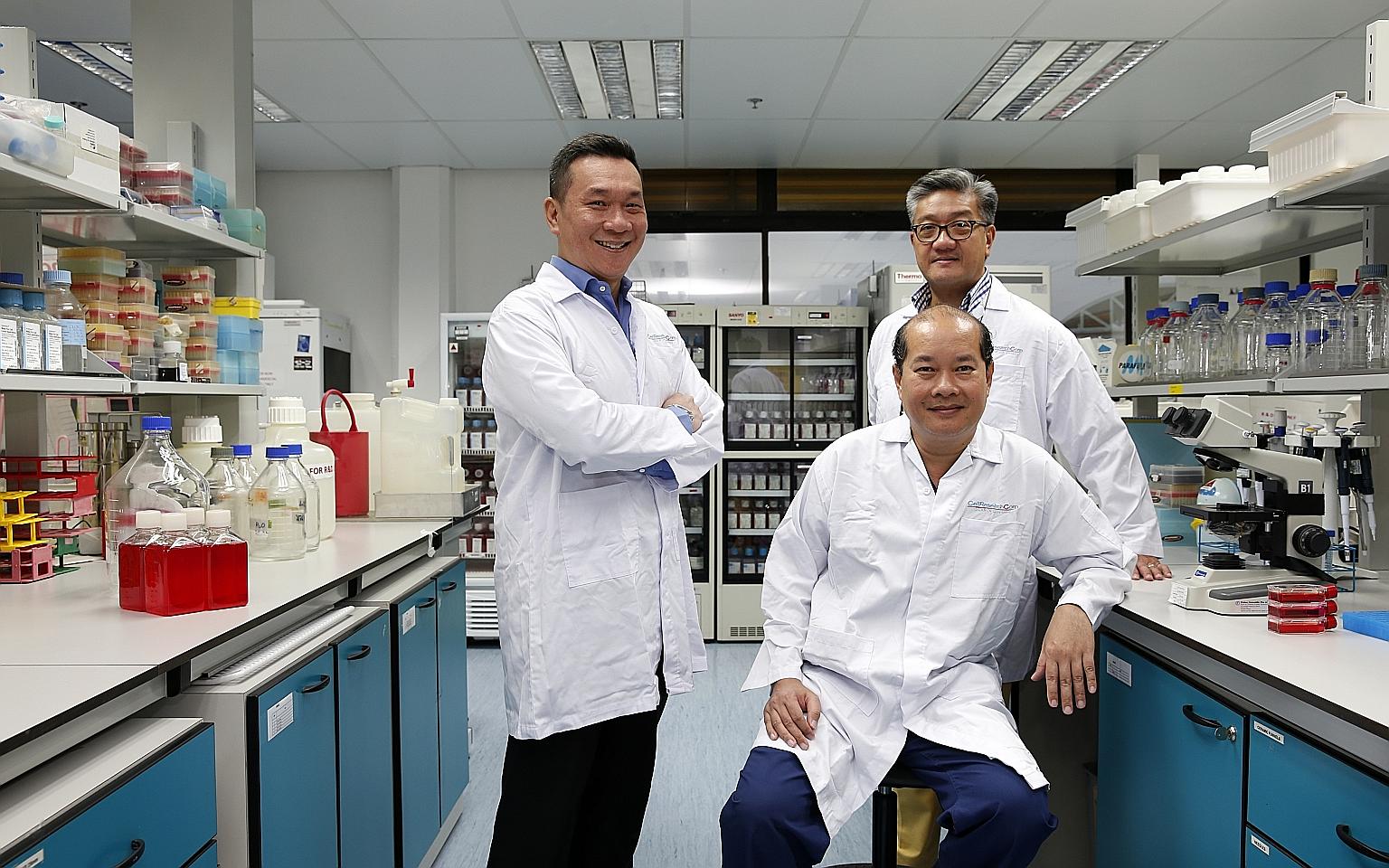FDA trial for S'pore biomedical company
CellResearch Corp gets approval for human trials using stem cells from cord lining
Sign up now: Get ST's newsletters delivered to your inbox

CellResearch - founded by (standing from left) group chief medical officer Ivor Lim, group chief executive Gavin Tan and group chief scientific officer Phan Toan Thang (sitting) - is now worth $700 million and has 39 patents worldwide.
ST PHOTO: CHEW SENG KIM
Samantha Boh
Follow topic:
Diabetic wounds are notoriously difficult to treat, but a Singapore biomedical firm believes it has succeeded in doing so, and has received the nod from the United States Food and Drug Administration (FDA) to test its treatment on patients.
If its trials are successful, this opens the multibillion-dollar world market to CellResearch Corporation's unique stem cell treatment, which does away with the need for skin grafts.
"This is a huge thing," said CellResearch group chief medical officer Ivor Lim, pointing out that being able to produce the clinical- grade stem cells was a breakthrough that took years. Human cells are allowed for transplantation only if they are of such quality.
The firm will start its first FDA-approved trial, in Colorado in the US, on 30 to 100 patients early next year, using stem cells extracted from umbilical cord lining - normally discarded when a woman gives birth - that can grow into the patient's new skin. The trial is expected to last two to three years.
The firm received the FDA stamp of approval after showing it could produce Good Manufacturing Practice (cGMP) mesenchymal stem cells - which can transform into a variety of cell types - at a University of Colorado laboratory. They have named the drug CorLiCyte.
According to a report by global research and consulting firm MarketsandMarkets, the global wound-care market is expected to grow from US$17 billion (S$24.4 billion) this year to hit US$20.4 billion by 2021.
Many countries take their cue from the FDA in deciding whether drugs and treatments are safe and effective, and the CellResearch team hopes the treatment will be made available to patients in Singapore within a few years.
Diabetes is a serious concern here, and diabetic wounds can remain open for months, running the risk of infection, gangrene and even amputation.
Dr Toh Sue-Anne, senior consultant at the National University Hospital's division of endocrinology, said stem cells from cord lining offer a promising approach to wound therapy in patients with diabetes, because they release growth factors and cytokines, and cell signalling molecules that stimulate new vessel formation and regulate inflammation.
"If clinical studies can build on the successes of the basic and translational research, this could revolutionise how we manage wound care in the clinic," she said. This milestone is the latest in the company's rags-to-riches story that started in 2004, with what Dr Lim described as an accidental discovery.
Then, group chief scientific officer Phan Toan Thang had been examining the placenta for alternative skin cells when he chanced upon the previously untapped stem cell source in the umbilical cord lining. He discovered that the umbilical cord lining contains a treasure trove of two types of stem cells: epithelial stem cells - which can transform into tissue lining; and mesenchymal stem cells - which can turn into a variety of cells.
With this plentiful and easily available source of stem cells, researchers can bypass the controversial harvesting of stem cells from human embryos. Such human embryonic stem cells can transform into any cell the body needs, but extracting them destroys the days-old embryo.
The cord lining can provide a whopping six billion stem cells to expand into skin, bone, the cornea and other parts, with close to 100 per cent purity. In comparison, the purity of stem cells extracted from bone marrow is about 65 per cent.
"It's like gold mining. You get gold, but 40 per cent is rock and sand and other impurities you don't want," said Dr Phan. "But we have found a gold mine that's 99 per cent gold."
CellResearch, founded by Dr Lim, Dr Phan and former investment banker Gavin Tan, the company's group chief executive, is now worth $700 million and has 39 patents worldwide, including those for extracting stem cells from umbilical cord lining, banking and cultivating them, and for treatments.
The company said it has healed 3,000 difficult-to-heal wounds in patients in Vietnam, and repaired the cornea, restoring vision in more than 80 eyes.
Its success comes at a time when labs are struggling to take stem cell research to market, as there are many regulatory hurdles before treatments can be proven safe and effective.
CellResearch is also working with 11 other groups in Singapore and internationally to harness stem cells for treatments for a variety of conditions, from Parkinson's to hearing loss and heart repair.
"We were just trying to get enough cells in an inexpensive way for skin repair - that was our first intention," said Dr Phan.
"Then we discovered that a lot more can be done beyond skin needs."
Associate Professor Lim Kah Leong of the National Neuroscience Institute and National University of Singapore's Yong Loo Lin School of Medicine - who is studying the use of cord lining stem cells to repair damaged brain cells in Parkinson's patients - said having cGMP-grade stem cells will aid research.
"It paves the way for future clinical trials as we don't need to go through as many regulatory roadblocks," he said. "You can also apply it to human patients without concern that there could be contamination issues."

